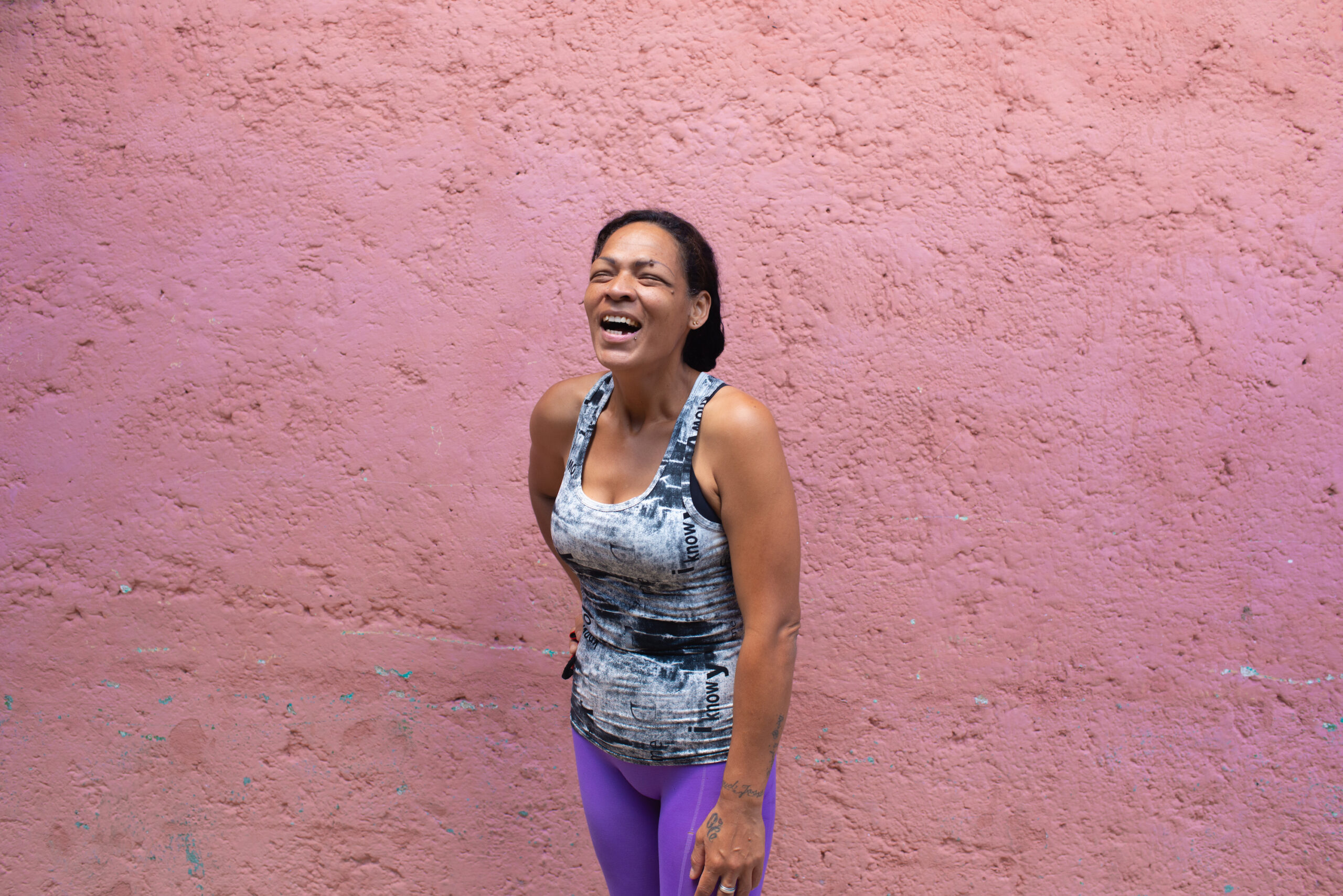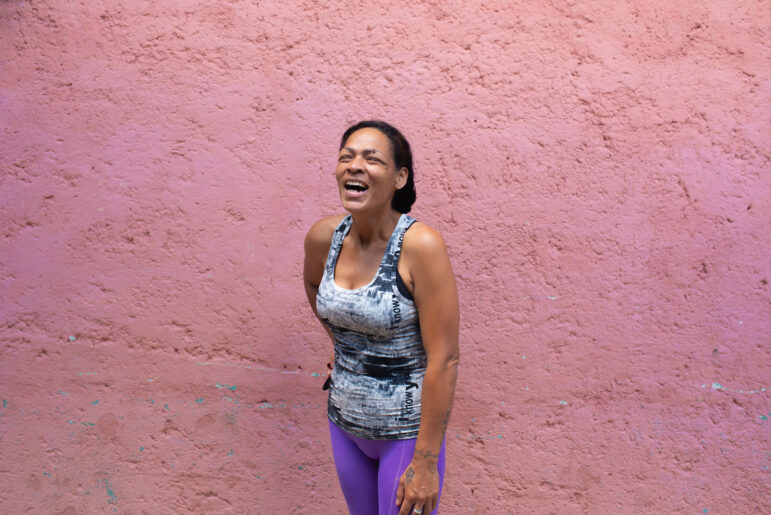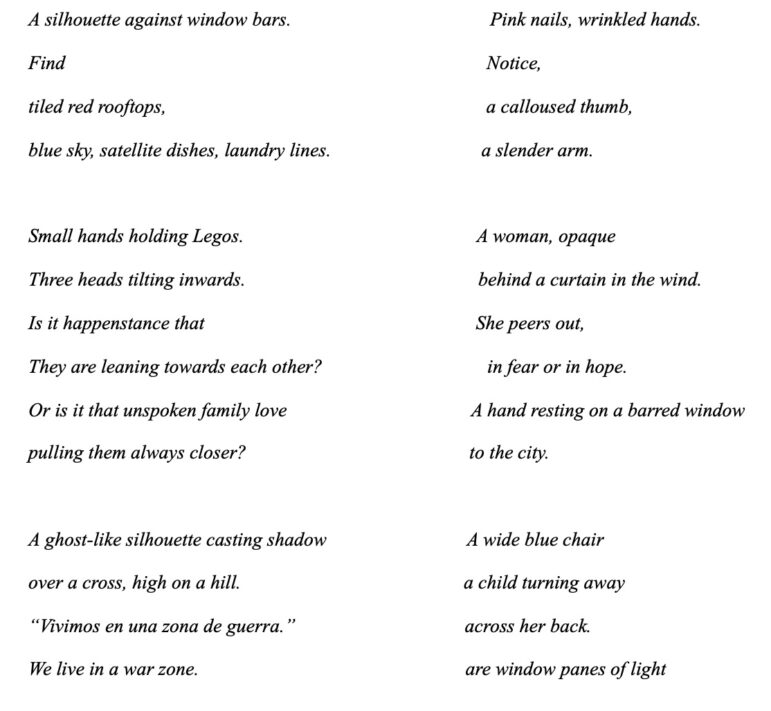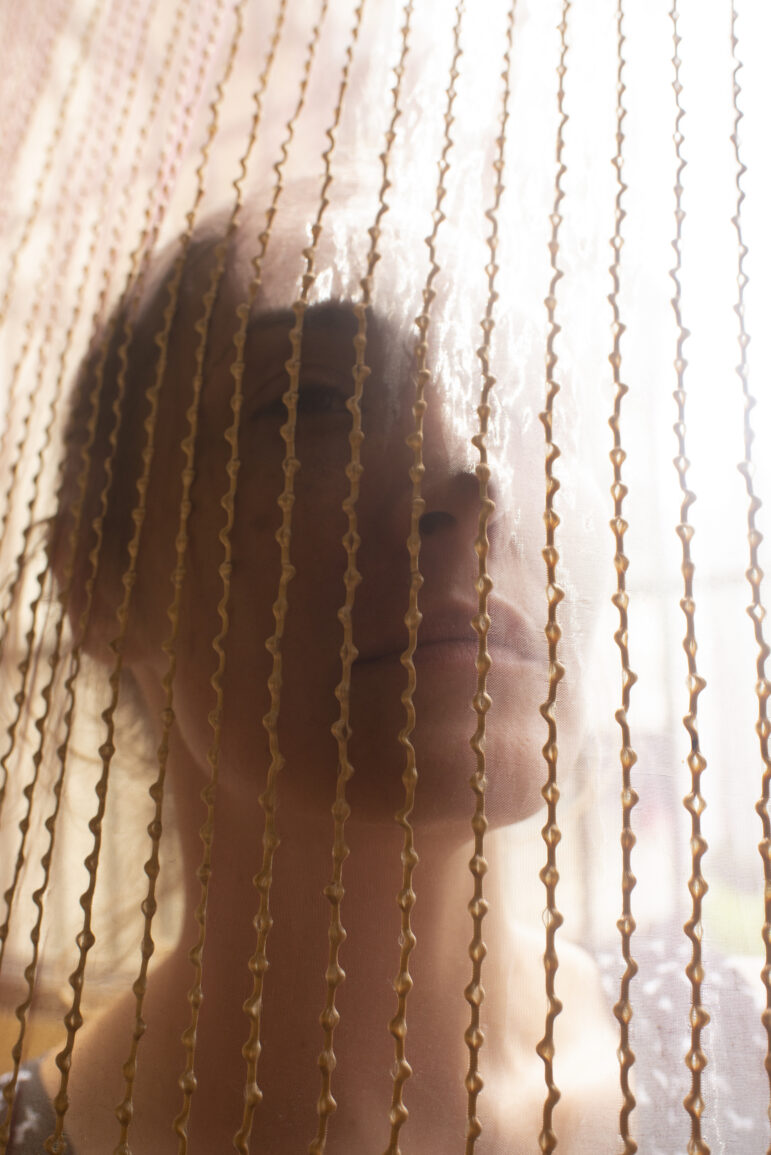
CARACAS, SEPTEMBER 2020. Deisy smiles as she walks in her neighborhood at the top of Petare, the largest barrio in Caracas. Deisy works as a maintenance worker in an upper class enclave of the city. She has been able to work throughout the pandemic, allowing her to provide for her husband- suffering from pancreatic cancer- and her fifteen year old son.

Share
Venezuelan-American Photographer Lexi Parra Teaches Collaboration and Resilience
Arriving
My arrival in Venezuela begins with screaming. Entra, mi tia:“How dare you treat someone who is coming to teach children this way!” I am detained in Barcelona, a small town in western Venezuela. Security personnel are suspicious of me. “What am I photographing?” “¿Quien te envió aquí?”
Tia’s shouting works, I am released. This heat. Dizzying. I stay with my family in Barcelona. The energy is tense. Nicolas Maduro has recently been re-elected president for a second six year term. There are generals patrolling the town.
After a few days with family, I make my way to Caracas. “¿Recuérdame? Lexi? The girl who emailed you?” They do. Relief.“Entra y vamos a hablar.”
I’m in a haze all summer; this country feels both deeply familiar and completely foreign to me.
I am just beginning.
Breaking up with Tradition
Venezuelan-American Photographer Lexi Parra is moving away from the individualistic “I” and towards the collective “we” of creating art for the gain of many, not the personal success of one. Working with womxn mentors in Latin America has provided the photographer with artistic communities where exclusivity in the photojournalism field is being questioned and reimagined.
Growing up in Minneapolis, Lexi was introduced to image making as activism by her father, documentary filmmaker Andrés Parra. Her longtime interest in photography led her to study at Bard College’s renowned photography program. It was at this small liberal arts school in upstate New York where I met Lexi and, ultimately, found someone to resonate with on the empty hierarchy of elite arts spaces. The photography program in particular was the pinnacle of white, liberal elitism; unaffordable and mediocre. When Lexi reflects on her experience at the school, she too is clear in her critique of the program:
“I was really grateful for the [Bard photography] program…I hadn’t had the opportunity to learn that kind of fine art photography, that was really cool.” Lexi pauses, her expression hard to discern, “but I was also taught by a lot of old white men, you know…there are drawbacks in terms of being a young woman of color.”
These “drawbacks” reflect the downfalls of the photography field as a whole; white, male, and expensive. In addition to the lack of representation in academia and media spaces, the photojournalism field has a history of integrating bias into the technology of the lens itself; making it harder for people of color to be photographed accurately. Lexi says she “didn’t get to interrogate a lot of the questions about photojournalism and the power of a photograph outside of its aesthetic value until I [she] got into the field after graduation.”
In addition to being one of a handful of students of color in the photo department, she also found herself isolated in the desire to shift away from the typical photojournalism language. The “capturing” or “taking” of an image speaks to how embedded appropriation is in the world of images. Rather than “shoot” a story, Lexi is interested in collaborative storytelling techniques and explores the question; what power dynamics are involved in telling someone else’s story?
In a period overwhelmed by drastic images of understaffed hospitals and sick patients, Lexi’s image practice is a model for showing the nuances of longing. She captures the softness of grief, the silliness of pain, the joy of having just enough to pay the bill. The U.S., now one of the most desperate countries in the world, is still adjusting to our status as being the country in need of aid. COVID-19 has exposed the lack of infrastructure and solidarity in our country, and the necessity of community based support; images of our shortages of supplies, and crumbling healthcare system is the leading storyaround the world every day. What can we learn from Lexi’s practice to help us tell the stories of community power that are rooting and growing out of the fissures of sorrow?
In the Field
After being awarded a Davis Projects for Peace grant in 2018, Lexi took her first extended trip to Venezuela to teach photography at the Tiuna el Fuerte Cultural Center in Caracas. It was the opposite of the experience at Bard; hands on, community based, and non-hierarchical. The grant was intended to support a summer initiative only, but after three months she was just getting started. Two years later, Lexi is still living in Caracas and has created MiRA Venezuela; a mobile grassroots arts education initiative.
“There was no way I could go back to New York and get an office job at a photo agency and feel like I did something here,” Lexi says when discussing her decision to stay, “it was a lot of personal evolution getting to feel connected to my country and my history.”
MiRA is staffed by Lexi and 3 other local team member photographers who travel to neighborhoods around Caracas to share photography practices and collaborate with other kinds of artists. Her eyes brighten when describing working with a local musician to create an album with a group of her students and the joy of watching young people create.
“Here at MiRA, we work to empower youth through photography, we work to use the camera as a tool for them to tell their own stories, and the classrooms to have critical conversations that touch, specifically, on female empowerment, the difficult realities that youth are facing today, and the conversation of how to choose your own future.”

Lexi Parra
CARACAS, SEPTEMBER 2020. Deisy smiles as she walks in her neighborhood at the top of Petare, the largest barrio in Caracas. Deisy works as a maintenance worker in an upper class enclave of the city. She has been able to work throughout the pandemic, allowing her to provide for her husband- suffering from pancreatic cancer- and her fifteen year old son.Photographing Dignity
Scrolling through Lexi’s instagram feed is a musical experience; where stories are told as harmonies rather than hierarchies. The hours she spends connecting with people are immediately evident in her images. Her photographs are a poetic wash of colors that require multiple viewings to reveal all of their layers. To look once is to hear the melody, to keep looking is to listen to the song.
“To me, the day to day is interesting, I am not as interested in big moments of clash or showing extreme poverty in an exploitative way. I do go to neighborhoods that are very poor. But I would photograph somebody in their home just as I would photograph someone in a New York penthouse apartment.”
Seeking subtlety over drama, the images invite viewers into the intimate details of everyday life. The most accurate way I know to translate the deeply emotive photographs is through poems:


Lexi Parra
CARACAS, VENEZUELA – MAY 2020. Pamela poses for a portrait in her home. She lives at the entrance to the notorious barrio, El Setenta, which has been experiencing police raids and gang violence – part of a years’ long war.Persevering is an Art Form
Like Lexi’s multi-layered photographs, Venezuela is difficult to categorize. Yet, the constantly changing political landscape is one of Venezuela’s strengths in fighting COVID19. “Solidarity is a theme throughout every day,” Lexis says, and it has been crucial to persevering through months of militarized lock down.
Lockdown in Caracas means you cannot leave home without a government issued pass, wearing a face mask is legally enforced, and alcohol is banned. But there are, “10,000 ways that we get around it,” Lexi says. There are performances outside of public housing units; people peering from rooftops to watch a circus unfold in the plaza. There are DJs who bring music into lower income communities with unstable wifi; there are moto taxi drivers who know the back routes where a government pass isn’t necessary. Bring a bag, pay in cash and you can get all the alcohol you need.
In this moment of cataclysmic change, Lexi Parra is leading the way for photojournalism to become a more equitable and accurate field. Through her lens, she reveals how community solidarity is the strength of her “beautiful and heartbreaking country”; words that could also be used to describe the United States.
The US now faces the question of how to transform our devastation into fertile soil for a new kind of country. She offers us some practical steps.
Lessons
Partners, Not Subjects
“There’s this idea of hunting the story, getting access, your subjects, even the language is very possessive.”
Working collaboratively is an art form and the people we work with are not ‘ours.’ Lexi describes how the masculine aspect of photography often brings unnecessary attention to the gory details of a situation. But what does always showing a community at their lowest point actually do for them? Supporting a community is not only about exposing pain, but about being partners in making change and uplifting existing strength and resilience.
Look Away From the Crowd
“The best advice I have received is that when there are protests in the city, instead of always going toward that image of somebody throwing a molotov cocktail or a group of people doing their disobedience, look away from where the other cameras are looking, look away at the people who are watching, the guards who are standing by, the images that are reinforcing the same cliches of political clash.”
Begin by asking: What story has been told about this place, group, or issue? Go beyond the pop culture news cycle of death and despair and explore what’s happening in the periphery.
The Revolution is Quiet
“ I am interested in understanding how life goes on within the framework of a crisis…to speak to those quieter moments that also exist.”
What are the subtle moments of revolution? Lexi notes that protests are only one aspect of political strife. Open your eyes, she advises, to the places where no one else is looking.
Simple, Transformative
“You don’t need that much to be able to build a connection. We’ve been doing it here for seven years in ridiculous conditions, and I learn every single day from people here, and I’m sure that I will never stop learning.”
MiRA Venezuela’s slogan is, “Hay un Horizonte.” There is a horizon. The program travels to neighborhoods where there is cyclical violence, where harsh realities prevent kids from being kids. According to Lexi, more money or material items are not what’s needed to make social change. Rather, “engaging with art is a simple but transformative way to show that they [the students] have a voice, they have something to say.” What I do, she says, “is listen.”

